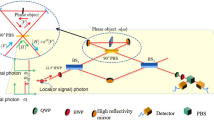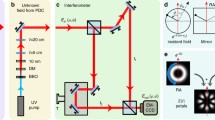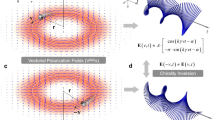Abstract
It is of great significance to measure tiny Doppler frequency shifts precisely, for its importance in velocity measurement. However, the precision of classical measurement schemes for tiny Doppler frequency shifts is restricted by the shot noise limit. The emergence of quantum weak measurement can significantly reduce technical noise compared with classical measurements. Here, a scheme to realize tiny Doppler measurement by using quantum weak measurement technology is proposed. This scheme realizes the coupling of the polarization state and the transversal position state of a beam and then post-selects the polarization state. Finally, the tiny Doppler frequency shifts are amplified. At the same time, the energy recycling technology is incorporated to increase the best measurement precision by 1000 times compared with the classical measurements. Considering the loss in the energy recycling cavity, we draw the following conclusion: When the loss rate in the cavity does not exceed 20%, the precision of our scheme can be twice of the shot noise limit of the classical measurement.







Similar content being viewed by others
Data Availability Statement
This manuscript has no associated data and the data will not be deposited. [Authors' comment: This is a theoretical study and no experimental data.]
References
Y. Aharonov, D.Z. Albert, L. Vaidman, How the result of a measurement of a component of the spin of a spin-1/2 particle can turn out to be 100. Phys. Rev. Lett. 60, 1351 (1988)
J. Dressel, M. Malik, F.M. Miatto, A.N. Jordan, R.W. Boyd, Colloquium: Understanding Quantum Weak Values: Basics and Applications. Rev. of Mod. Phys. 86, 307 (2013)
H.F. Hofmann, Complete, characterization of post-selected quantum statistics using weak measurement tomography. Phys. Rev. A 81, 15780–15787 (2010)
Y. Aharonov, A. Botero, Quantum averages of weak values. Phys. Rev. A 72, 762–776 (2005)
Y. Kedem, Using technical noise to increase the signal-to-noise ratio of measurements via imaginary weak values. Phys. Rev. A 85, 121–125 (2012)
N. Brunner, C. Simon, Measuring small longitudinal phase shifts: weak measurements or standard interferometry? Phys. Rev. Lett. 105, 010405 (2010)
O. Hosten, P. Kwiat, Observation of the spin hall effect of light via weak measurements. Science 319, 787–790 (2008)
P. Piyush, M.S. Giridhar, G.R. Jayanth, A high bandwidth three-axis out-of-plane motion measurement system based on optical beam deflection. Rev. Sci. Instrum. 89, 035003 (2018)
V. Trivedi, M. Joglekar, S. Mahajan et al., Portable device based on beam deflection for refractive index mapping and diffusion coefficient measurement. Opt. Eng. 58, 014101 (2019)
P.B. Dixon, D.J. Starling, A.N. Jordan et al., Ultrasensitive Beam Deflection Measurement via Interferometric Weak Value Amplification. Phys. Rev. Lett. 102, 173601 (2009)
S.J. Park, H.J. Kim, J.W. Noh, Weak value measurement of an optical beam deflection in image rotating sagnac interferometer. J. Opt. Soc. Korea 16, 277–281 (2012)
J.M. Hogan, J. Hammer, S.-W. Chiow, S. Diclcerson, D.M.S. Johnson, T. Kovachy, A. Sugarbaker, M.A. Kasevich, Precision angle sensor using an optical lever inside a Sagnac interferometer. Opt. Lett. 36, 1698 (2011)
M.D. Turner, C.A. Hagedorn, S. Schlanvninger, J.H. Gundlach, Picoradian deflection measurement with an interferometric, quasi-autocollimator using weak value amplification. Opt. Lett. 36, 1479 (2011)
G.I. Viza, Martínez-Rincón, Julián, Howland G A, et al, “Weak-values technique for velocity measurements.” Opt. Lett. 38, 2949–2952 (2013)
N. Striibi, C. Simon, Measuring small longitudinal phase shifts: weak measurements or standard interferometry? Phys. Rev: Lett. 105, 010405 (2010)
G. Brunner, C. Bruder, Measuring Ultrasmall Time Delays of Light by Joint Weak Measurements. Phys. Rev. Lett. 110, 083605 (2013)
A. Feizpour, X. Xing, A.M. Steinberg, Amplifying single-photon nonlinearity using weak measurement. Phys. Rev. Lett. 107, 133603 (2011)
X.Y. Xu, Y. Kedem, K. Sun et al., Phase estimation with weak measurement using a white light source. Phys. Rev. Lett. 111, 033604 (2013)
G. Jayaswal, G. Mistura, M. Merano, Observing angular deviations in light-beam reflection via weak measurements. Opt. Lett. 39, 6257 (2014)
Y.T. Wang, J.S. Tang, G. Hu et al., Experimental demonstration of higher precision weak-value-based metrology using power recycling. Phys. Rev. Let. 117, 230801 (2016)
S. Wu, Y. Li, Weak measurements beyond the Aharonov-Albert-Vaidman formalism. Phys. Rev. A 83, 052106 (2011)
O. Pinel, J. Fade, D. Braun, P. Jian, N. Treps, C. Fabre, Ultimate sensitivity of precision measurements with intense Gaussian quantum light: A multi-modal approach. Phys. Rev. A 85, 1–4 (2012)
S. Pang, J. Alonso, T.A. Brun et al., Protecting weak measurements against systematic errors. Phys. Rev. A 94, 012329 (2016)
Y. Qin, Y. Li, H. He, Q. Gong, Measurement of spin Hall effect of reflected light. Opt. Lett. 34, 2551 (2009)
Y. Qin, Y. Li, X. Feng, Y.-F. Xiao, H. Yang, Q. Gong, Observation of the in-plane spin separation of light. Opt. Express 19, 9636 (2011)
G. Jayaswal, G. Mistura, M. Merano, Weak measurement of the Goos-Hänchen shift. Opt. Lett. 38, 1232 (2013)
Funding
This research was supported by National Natural Science Foundation of China (62075049) and (61701139).
Author information
Authors and Affiliations
Corresponding author
Ethics declarations
Conflict of interest
The authors declare that there are no conflicts of interest related to this article.
Appendix
Appendix
In this part, we give the formula derivation process of the measurement precision and signal-to-noise ratio of the split detector.
According to the quantization theory of electromagnetic field and the related theory of split detection, the electromagnetic field can be expanded under a set of orthogonal basis vectors. The expression of the positive frequency part of the electromagnetic field is
In the above formula, \(\omega\) is the frequency of the electromagnetic field, c is the speed of light, T is the detection integration time, \(\varepsilon_{0}\) is the permittivity of free space, \(\hat{a}_{n}\) is the annihilation operator of the nth-order mode, and \(u_{n} \left( x \right)\) is the n-order Hermite Gaussian mode. After linearizing the annihilation operator, we can get that only the average value of the n-order Hermite Gaussian mode is not 0, and then, when there is a transversal displacement \(d\), the positive frequency part of the signal light can be written as
The laser beam is incident on the split detector, and the split detector needs to subtract the photocurrent measured by the two parts to obtain the difference in the photon number as
Taking Eq. (8) into Eq. (9) and omitting higher-order terms, we get
Then, the signal-to-noise ratio satisfies \({\text{SNR}} = \left( {{{d\sqrt {{2 \mathord{\left/ {\vphantom {2 \pi }} \right. \kern-\nulldelimiterspace} \pi }} 2\sqrt N } \mathord{\left/ {\vphantom {{d\sqrt {{2 \mathord{\left/ {\vphantom {2 \pi }} \right. \kern-\nulldelimiterspace} \pi }} 2\sqrt N } {\left( {w_{0} \delta \hat{X}} \right)}}} \right. \kern-\nulldelimiterspace} {\left( {w_{0} \delta \hat{X}} \right)}}} \right)^{2}\).
For coherent light, \(\langle {\delta^{2} \hat{X}} \rangle = 1\),
When SNR = 1, we can get the error formula of the displacement measurement
Rights and permissions
About this article
Cite this article
Wang, Z., Zhang, Z. & Zhao, Y. High-precision measurement of tiny Doppler frequency shifts based on quantum weak measurement with energy recycling. Eur. Phys. J. Plus 136, 878 (2021). https://doi.org/10.1140/epjp/s13360-021-01883-1
Received:
Accepted:
Published:
DOI: https://doi.org/10.1140/epjp/s13360-021-01883-1




